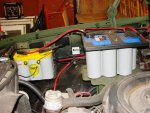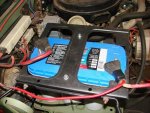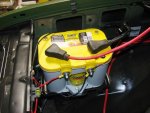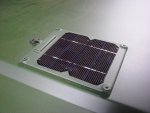Tech Tips – Powered by OPTIMA Batteries®
Tech Tip #3 – Don't Throw Away Your "Dead" AGM Battery: Three Tips on Resuscitating a Deeply Discharged AGM Battery
Like a ghost story, sometimes the seemingly dead really aren't dead at all. The same may be true for your over-discharged AGM battery.
In time, AGM batteries, including OPTIMA batteries, may fail. Failures are typically caused when a starting battery is used in a cycling application, in which a deep cycle battery is the better choice.
Okay, so now you have a seemingly bad AGM battery, you attach it to your charger and…CLICK. The charger won't even charge it! "It must be a bad battery!" you exclaim. Or is it? In many cases, OPTIMA batteries that are assumed to be bad may actually be perfectly fine, just deeply discharged.
The great thing about AGM batteries, including OPTIMA Red Top® and Yellow Top® batteries, is that they have incredibly low internal resistance. This allows very high amperage output and for the battery to accept a charge very quickly.
An AGM battery, with its low internal resistance, may stump car guys because sometimes it doesn't work like a traditional flooded lead acid battery.
Here's the problem: most battery chargers have built-in safety features. A traditional battery that's at 10.5 volts or less is seen as defective, having either a short, a bad cell or some other defect. The charger "knows better" than to charge a defective battery because the results could be unsafe. But the fact is the AGM battery is just fine; it has simply slipped below the minimum voltage threshold of the charger and the charger doesn't know what to do with the battery.
Here are three options for bringing that fine AGM battery back to life. So grab your jumper cables and charger and…CLEAR!
Recovery Option #1: The Best Solution – AGM-Specific Chargers
The best method for recharging a deeply discharged AGM battery is to purchase a modern charger that has kept up with battery technology. Many chargers now have AGM-specific settings and de-sulfation steps that help recondition and recover deeply discharged AGM batteries. These are becoming more common, and they work well for all lead acid batteries. They have the additional capability of doubling as a battery "maintainer" for vehicle storage. Some come with additional wiring to permanently attach leads from your battery to an accessible spot on your vehicle. This makes it easy to hook up when you store your car, truck, boat or RV.
OPTIMA Batteries does not officially endorse specific chargers—we simply don't have the time to test all of the excellent chargers on the market. There are a few that our customers and staff have tried and liked. You can contact OPTIMA Batteries Customer Service at 888-8-OPTIMA (888-867-8462) or via email at
info@optimabatteries.com for charger recommendations based on different applications.
Recovery Option #2: The DIY Solution
This is a recovery method for the do-it-yourselfer using the equipment you've got in the garage. With this option, you're going to trick your charger into charging the deeply discharged AGM battery.
Here's what you need:
- Battery charger
- Jumper cables
- A good battery, preferably above 12.2 volts (It can be an AGM or flooded battery, it doesn't matter.)
- The seemingly dead, deeply discharged AGM battery
- A watch or timer
Now, here's what you do:
- Hook up the good battery and deeply discharged AGM battery in parallel—positive to positive and negative to negative. Do not have the charger connected to the battery or turned on at this stage.
- Now, hook up the good battery to the charger. Turn on the charger. The charger will "see" the voltage of the good battery, and start providing a charge.
- After the batteries have been hooked up for about an hour, check to see if the AGM battery is slightly warm or hot to the touch. Batteries naturally become warm during charging, but excessive heat may be an indication that there really is something wrong with the battery. Also discontinue the process if you hear the battery "gassing"—a hissing sound coming from the safety valves. If it's hot or gassing, STOP CHARGING IMMEDIATELY!
- Check back every hour to see if the AGM battery has charged to 10.5 volts or above. If it has, disconnect the charger from the wall outlet and remove the good battery from the charger. Now, connect only the deeply discharged AGM battery to the charger. Turn on the charger and continue until the AGM battery reaches a full charge, or until the automatic charger completes the charge process. In most cases, the AGM battery will be recovered.
Recovery Option #3: Enlist the Professionals
If you don't own a battery charger, you don't want to make the investment, or you're not the do-it-yourself kind of guy, this is the option for you.
Take the battery to a professional battery specialist who knows AGM technology. Most specialists are willing to provide "charge and check" procedures free or for a small fee. Auto parts stores are typically not capable of accurately determining an AGM battery's condition, and many use conductance testers that don't provide correct readings. Battery specialists like Interstate Batteries and other independent battery distributors are experts who can help determine if your battery is recoverable or not.





